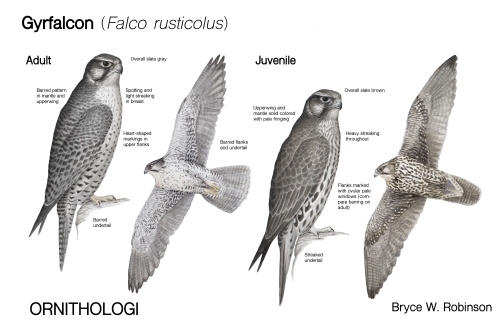Differentiating Adult and Juvenile Gyrfalcon (Falco rusticolus)
by Bryce W. Robinson

Given that much of my career has been focused on the world’s largest falcon, the Gyrfalcon, I often get questions about their life history and Identification. A recurring question is the age of individuals that are observed in winter. Most often, folks ask about juvenile vs. adult, so I decided to make available a simple illustration with annotations as a reference for those with these questions.
What I’ve realized is that fleshy parts confuse a lot of people, since an adult should have yellow legs and cere, whereas a juvenile should have blue. However, it takes female birds much longer to change (well into their second year), and the coloration is also influenced by individual quality and hormones. Some adults, particularly females, tend to be quite dull in the winter (compare this with observations of gull legs in winter, e.g. California Gull). Adults that are likely three years or older (given presence of retained feathers in the upper wing, etc.) can have surprisingly dull legs that may appear blue under certain conditions. The key then is to take a step back and focus on the plumage, since in most cases it is quite straight forward.
The illustration above aims to highlight the key points for aging a Gyrfalcon between adult and juvenile. Eventually I’d like to visually describe more micro-aging factors, but for now I think this will be a helpful resource for those more unfamiliar with this species.
Please, feel free to send me feedback and suggestions. Constructive criticism is always welcome.

Excellent post Bryce! And your artwork is absolutely outstanding!
Thanks Vic!
Hey Bryce,
Can you please send me your e- mail? I have a couple of photos I’d like to send you.
Bud